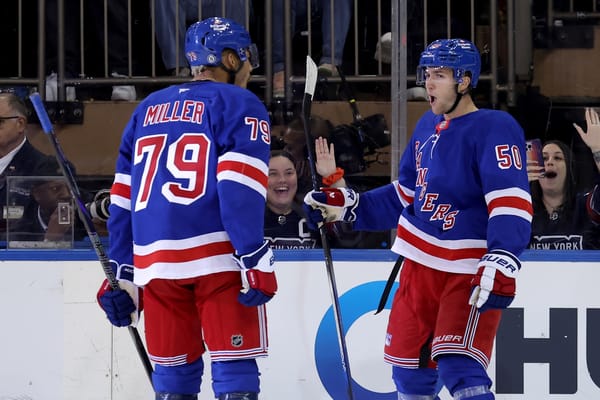Andersson Situation Highlights a Bigger Problem the Rangers Created Themselves
By holding too many cards at the start of the year, New York placed one too many obstacles ahead of their most promising youth
In a vacuum, the Rangers’ decision to cut bait on Lias Andersson by sending him back to the AHL on Friday afternoon isn’t a drastic one. It certainly stings in the interim given the optics, but the club is still rebuilding, which, contrary to popular sentiment isn’t synonymous with skating as many kids as possible. Sheep need shepherds.
Andersson still represents a significant measuring stick for how effective this rebuild can and will be, but his failure to stick full-time thus far isn’t damning for either party just yet.
”He’s made some great progress and he’s done some good things, but we just need to see more consistency out of him,” head coach David Quinn said in speaking to the media on the matter.
Via the New York Post:
“I know it’s difficult when he plays seven or eight minutes, but that’s just the situation we’re in. It didn’t make sense for him to stay here, especially with the limited practice time we’re going to have over the next three weeks. He needs to go play.”
This is something Jeff Gorton clearly recognized despite burning the first year of Andersson’s entry-level deal by recalling him back in early November as the team was dealing with a rash of injuries. Though it’s entirely fair to question just how smart of a move recalling the 20-year-old was in the first place with Seattle expansion on the horizon. Not to mention the simple year-to-year benefit of pocketing an extra entry-level slide with regard to eventual Unrestricted Free Agent (UFA) status.
It’s also fair to criticize the front office for recalling Andersson and then playing him under the conditions in which he was originally sent to Hartford out of training camp to avoid.
As a refresher, here is what Gorton said back in October at a town hall event about the decision to start Andersson in Hartford:
Quinn and the front office made no bones about their desire not to see Andersson boxed into a fourth-line role playing relatively meaningless minutes in the NHL when he could be playing a full-time role with the Wolf Pack instead. Yet that’s exactly what necessitated his return to the AHL yesterday, because it’s exactly the role he ended up in anyway.
”As I’ve touched on before, it’s not out of the ordinary that a 20-year-old is continuing to learn how to play consistently at this level,” Quinn continued. “He’s going to be a really good player, he’s making good strides, and he’s going to get to where we need him to be sooner than later. But we think [Hartford] is the best spot for him.”
Andersson logged 7:08, 10:33, 10:27, 6:09, and 9:24 respectively in his last five games, and has averaged 10:23 per game across 21 contests this season. Most of which was played on the Rangers’ fourth line. During that time he’s scored just one goal, added three assists, and fired 22 shots on goal. It goes without saying that his playing situation hasn’t been ideal, making it difficult to expect him to produce with such limited opportunities.
Whether or not he will actually learn any more playing in Hartford remains to be seen, but playing is clearly better than not, which was was a very real threat given the impending returns of both Jesper Fast and Cody McLeod to an already crowded forward lineup. Not to mention that center Boo Nieves remains on the roster, and it is unknown if he’ll remain with the club or is the next to be Hartford bound.
Still, while Andersson still has plenty of runway ahead of him to find his NHL footing, his demotion begets the problem the Rangers made for themselves in the first place in carrying this many NHL-ready players into the season. Saying nothing of the fact they were doing so in year one of a rebuild.
For example, keeping both Vladislav Namestnikov and Ryan Spooner likely wasn’t a good idea, and offering Cody McLeod a return ticket at all certainly wasn’t one. The Rangers were able to successfully parlay Spooner into a change-of-scenery trade for Ryan Strome, but the presence of both Namestnikov and Spooner coming out of camp made it that much harder for someone like Andersson to carve out a comfortable spot on the Rangers’ third line where he could likely have played alongside Brett Howden rather than been forced into competing with him directly. The amount of bodies on the roster even led to Filip Chytil being shifted to the wing in order to get the ice time he deserved.
This issue didn’t just affect the forwards, either. The late-summer acquisition of Adam McQuaid from the Boston Bruins set the Rangers on a path to carrying eight defenders – one they are inexplicably still experiencing. That’s not exactly an ideal gestation environment for the likes of Tony DeAngelo, or even Neal Pionk, who has found success in spite of this problem.
Perhaps this is all part of some grand design, hinged on a kind of unspoken “make them earn it” mantra, but a simple slice of Occam’s trusty razor suggests that unlikely. It’s much more likely the Rangers thought this all was a good idea. It was probably one in which they envisioned the presence of this many veterans as a kind of soft landing for the eventual failure of one or more prospects. On paper, that’s not a bad philosophy to have, but it’s clear they laid too much padding, which made failure a guarantee, rather than just a possibility.
But no matter which way you cut it, the Rangers made this bed, and so they’ll have to lie in it, now with year one on Andersson’s deal torched regardless of why.
However, though there’s no putting the toothpaste back in the tube, this issue is one that can thankfully be solved at any point or points between now and the February 25 trading deadline.
The NHL’s holiday roster freeze has been lifted, unofficially starting the clock on the what should prove to be the Rangers’ second-straight liquidation sale; one that promises to again clear the path for Andersson to return to Broadway. This time, perhaps, for good.
With pending UFA’s like Kevin Hayes, Mats Zuccarello, and Adam McQuaid all tumbling about the rumor mill to varying degrees, it’s entirely plausible to envision a sequence of events in which Gorton is able to carve another path for Andersson to make his way back up to the big club in the wake of their eventual absences. Provided most of what comes back to the Rangers in these trades isn’t additional roster players who will immediately block said path, of course.
In fact, depending on how heavy-handed Gorton decides to be, it’s even possible Andersson’s return could come with the added benefit of power play time or a top-six role. Perhaps even both. This was something that was discussed quite a bit in Banter’s recent round table discussion on Andersson which you can check out at the link below.
Related
Blueshirt Banter’s Round Table on Lias Andersson
Either opportunity for Andersson would do wonders in helping him make a much more emphatic impression where the worry of whether or not he’ll see even ten minutes in a given game a distant memory.
”It all depends on what our roster looks like next time he comes,” Quinn said of a possible return for the 20-year old Andersson. “A lot will be dictated by who we still have.”
Andersson’s first contract year is kaput, so there’s no real reason he shouldn’t just be left to figure things out in the NHL. But the logistics don’t really offer him a clear path to do so just yet. Not until the lame ducks sitting ahead of him eating up valuable lessons he could be learning are dealt for futures over the next two months.
It’s unlikely this was the path that Gorton and the coaching staff were hoping to have taken, but the damage to Andersson — if there is any at all — can be mitigated to near-zero if the general manager is bold enough to blaze him a path.
Ironic though it may be, all Andersson needs is a chance. Preferably one not littered with needless road blocks.




